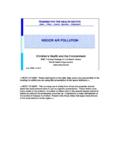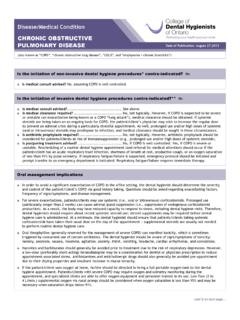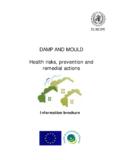Transcription of Rhinovirus Fact Sheet - infectionpreventionresource.com
1 2770 Coventry Road Oakville, Ontario L6H 6S2 Tel: 1-800-387-7578 Fax: (905)813-0220 Rhinovirus is a non-enveloped single stranded RNA encoding virus. It is part of the Picornaviridae (small RNA virus) family and usually affects the upper respiratory tract in humans. Approximately 99 serotypes of human rhinoviruses have been identified, and it is the major cause of the common cold. General Information Virology Rhinovirus is non-enveloped and has a single positive-strand RNA that is approximately 30 nanometres in diameter and have a naked nucleocapsid. They are found in an icosahedral capsid shape that contains 60 protomers in which contain 4 polypeptide proteins. Variations of these proteins account for the numerous serotypes of Rhinovirus .
2 As part of the Picornaviridae family, Rhinovirus types have recently become a species under the genus enterovirus. Rhinovirus prefers temperatures from 33-35oC, hence they replicate in the upper respiratory tract. Incubation is typically 2-4 days, and the host is most contagious at about 48 hours after initial exposure, sometimes persisting for approximately 3 weeks. Clinical manifestations There are many symptoms associated with Rhinovirus infection; they may include: rhinorrhea, blocked nasal passages, sneezing, coughing, sore throat, croup in infants and malaise. Rhinovirus is not typically harmful to mucosa cells, although infected cells may be sloughed off. The symptoms experienced depend on the number of virus particles replicated.
3 Infected cells produce a molecule called histamine that results in increased nasal secretions. It is the production of such molecules rather than direct cellular destruction that accounts for the symptoms experienced by the patient. Epidemiology of transmission Rhinovirus is transmitted through inhaling aerosols, nose to hand to nose contact and contact with contaminated surfaces. As little as one Rhinovirus particle is sufficient enough to cause infection. Rhinovirus is known to survive for approximately 3 hours on skin and 3 hours on inanimate surfaces. Transmission occurs when droplets are inhaled after an infected person coughs or sneezes. Transmission by inanimate surfaces involves contact with a contaminated surface and then touching your eyes, nose or mouth.
4 Basic Prevention Hand washing with plain soap and water is sufficient at removing virus particles off hands. Antibacterial soap is ineffective against viruses, therefore only plain hand soap is necessary. Alcohol-based hand sanitizers provide very little protection against potential upper respiratory infections, especially among children who are more susceptible. There is currently no vaccine for Rhinovirus . Rhinovirus Fact Sheet 2770 Coventry Road Oakville, Ontario L6H 6S2 Tel: 1-800-387-7578 Fax: (905)813-0220 Infection Prevention and Control Measures Healthcare Prevention Measures In addition to Routine / Standard Precautions, Droplet and Contact Precautions should be implemented with patients who are suspected or confirmed to have Rhinovirus infection.
5 Patients with suspected or confirmed Rhinovirus may be placed in private rooms or cohort with other patients with the same infection. Follow hand-hygiene guidelines by either carefully washing hands with soap and water or using Alcohol-Based Hand Sanitizers (ABHS) after contact Use gowns, gloves, face mask and eye protection when in contact with, or caring for patients and for all interactions that may involve contact with the patient or potentially contaminated areas in the patients environment Environmental control measures Products used for disinfection of Rhinovirus must have an appropriate non-enveloped claim. As a non-enveloped virus, Rhinovirus is more difficult to eradicate from the environment.
6 All horizontal and frequently touched surfaces should be cleaned daily and when soiled. All patient care equipment ( , thermometers, blood pressure cuff, pulse oximeter, etc.) should be dedicated to the use of one patient. All patient care equipment should be cleaned and disinfected as per Routine / Standard Practices before reuse with another patient or a single use device should be used and discarded in a waste receptacle after use. Toys, electronic games or personal effects should not be shared by patients. Rhinovirus symptoms are generally not life threatening; however, it is highly contagious and proper protocol is necessary to avoid transmission. References: 1. Virology - Chapter Ten Picornaviruses - Part Two: Rhinoviruses.
7 2. Rhinovirus Pathogen Safety Data Sheet - Infectious Substances. 3. Rhinovirus - Molecular Virology. 4. Rhinovirus . 5. Rhinovirus : An Unstoppable Cause of the Common Cold. Rhinovirus Fact Sheet






